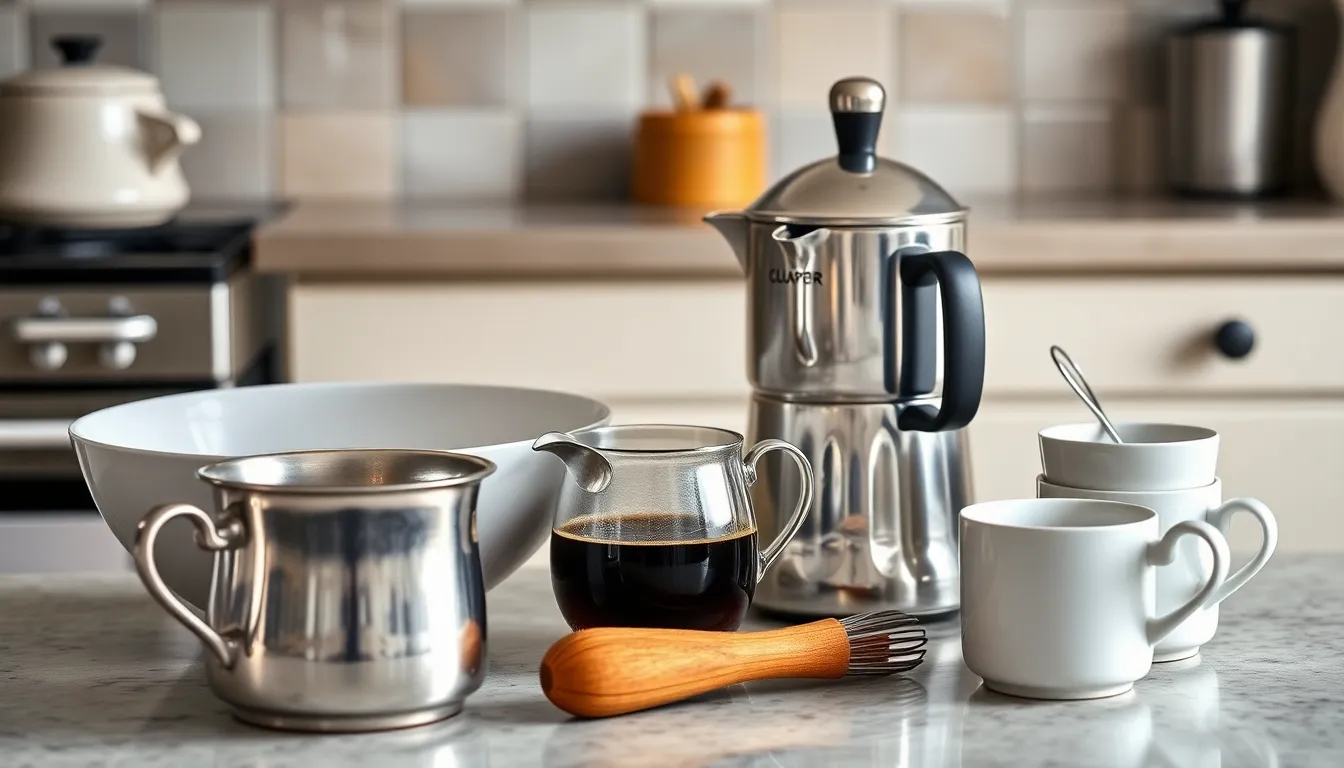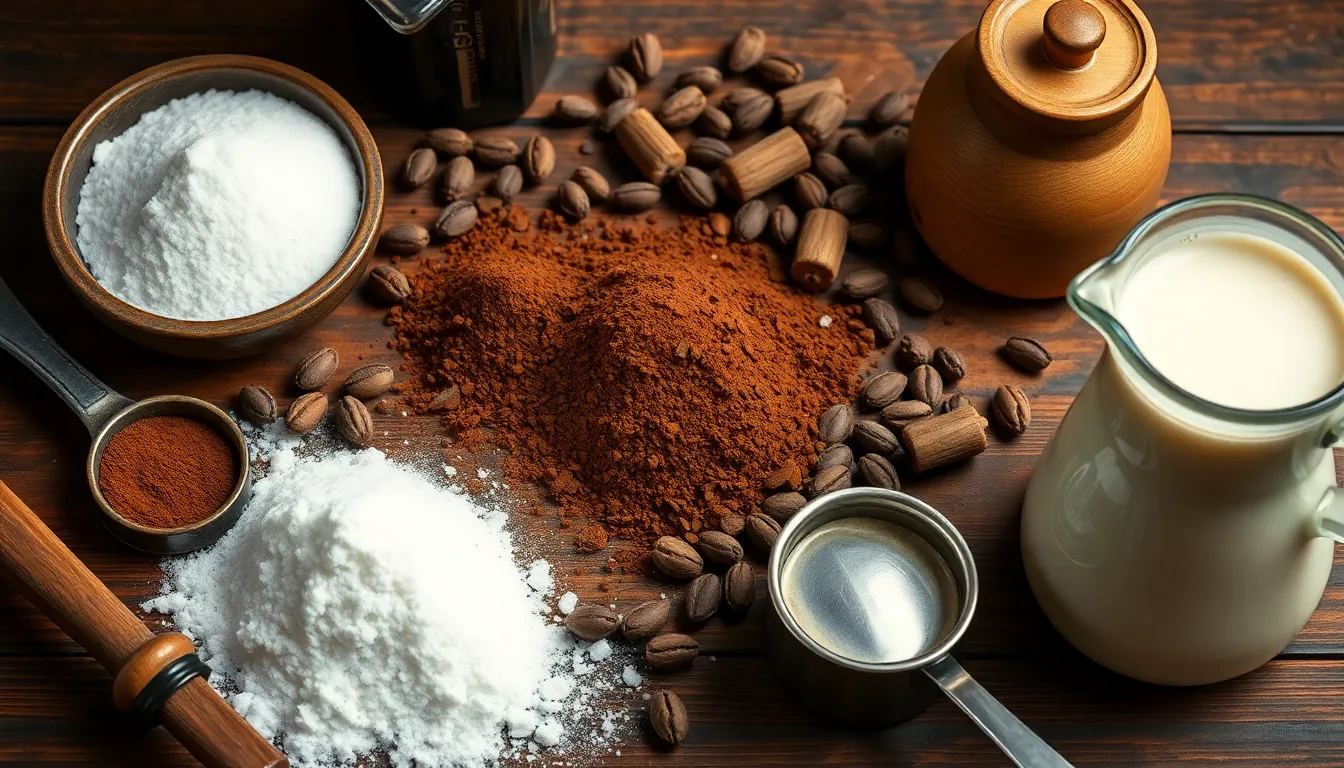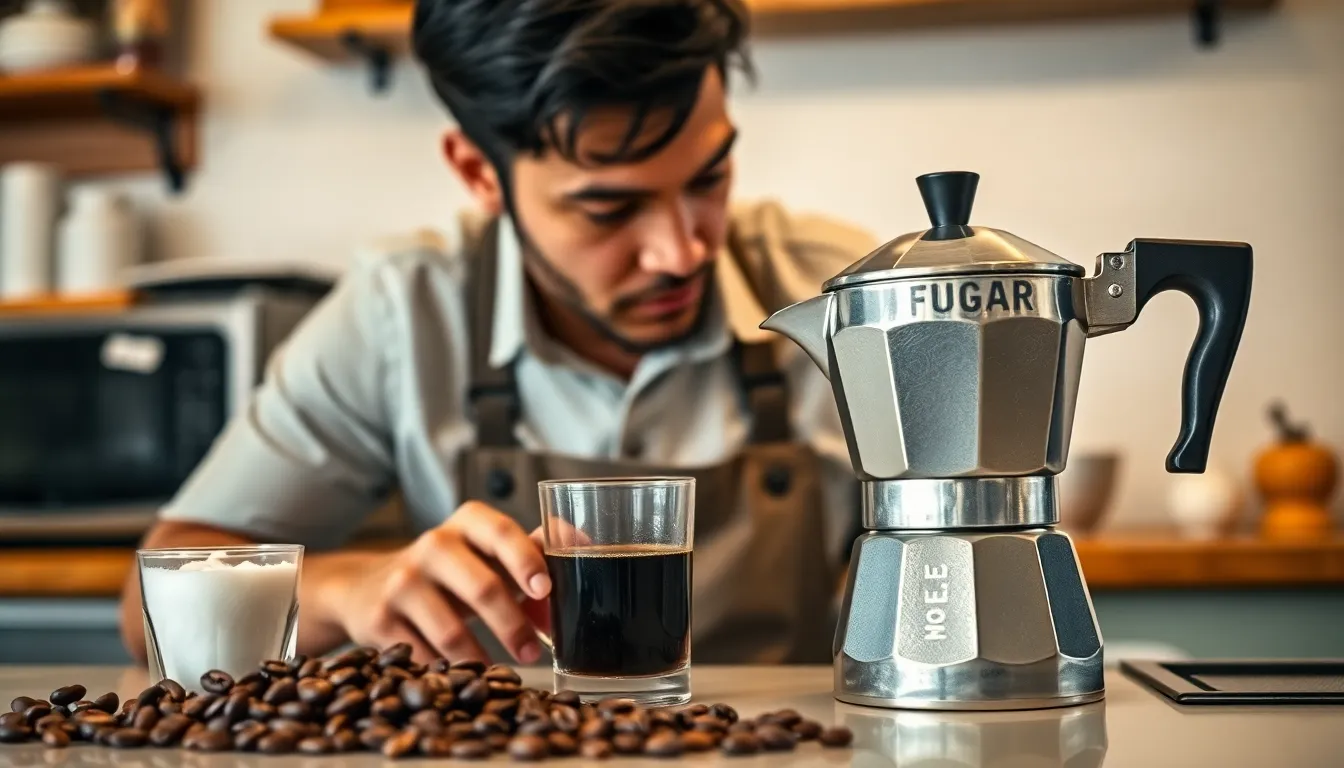We’ve all experienced that moment when regular coffee just doesn’t hit the same – that’s where Cuban coffee steps in to revolutionize your morning routine. This bold and intensely flavorful espresso-based drink isn’t just coffee; it’s a cultural experience that transforms your kitchen into a vibrant Havana café.
Cuban coffee, or cafecito, delivers an unmatched combination of rich espresso topped with a golden foam called espuma that’s created by whipping sugar with the first drops of brewing coffee. This traditional preparation method creates a drink that’s simultaneously sweet, strong, and absolutely addictive.
We’re about to share the authentic technique that’ll help you master this iconic beverage at home. With just a few simple ingredients and the right method, you’ll discover why Cuban coffee has captured hearts across Miami’s Little Havana and beyond. Get ready to elevate your coffee game with this time-honored recipe that promises to deliver café-quality results every single time.
What Is Cuban Coffee
Cuban coffee stands as one of the most distinctive espresso preparations in the industry. We know this traditional beverage as café cubano or cafecito in Spanish. The drink represents far more than just strong coffee served with sugar.
The defining characteristic lies in its signature espuma or crema. This golden foam forms when we whip the first few drops of freshly brewed espresso with granulated white sugar using vigorous circular motions. The technique creates a thick caramelized layer that floats on top of the dark coffee below.
Traditional preparation requires a stovetop espresso maker called a moka pot or cafetera. We brew dark roasted Cuban coffee beans at high pressure to extract maximum flavor and caffeine content. The result delivers an intensely strong coffee base that balances perfectly with the sweet espuma topping.
Cuban coffee differs from regular espresso through its preparation ritual and cultural significance. While standard espresso focuses on the pure coffee experience, café cubano emphasizes the harmony between bitter coffee and sweet foam. The drink serves as a social connector in Cuban households where sharing small portions throughout the day brings families and friends together.
Authentic Cuban coffee requires exact timing and technique. We must capture those initial drops of brewing coffee while they remain hot enough to dissolve sugar completely. The whipping process demands patience and persistence to achieve the proper foam consistency that Cuban coffee lovers expect.
Types of Cuban Coffee

Cuban coffee culture offers several distinct variations that each bring their own character to this beloved beverage. We’ll explore the three main types that showcase the versatility of café cubano and demonstrate how different milk ratios and serving sizes create unique experiences.
Café Cubano (Cuban Espresso)
This foundational Cuban coffee represents the purest expression of the traditional brewing method we’ve discussed. We start with 6 oz of filtered water and 1 tablespoon of finely ground dark roast coffee to create the perfect base. The magic happens when we remove about 1 tablespoon of the first brewed coffee and whisk it vigorously with 2 tablespoons of sugar until that signature caramel-colored espuma forms.
Our technique involves dividing this precious foam among the serving cups first. We then top each portion with the remaining hot coffee to preserve the espuma’s texture and visual appeal. This method ensures every sip delivers that perfect balance of bitter coffee and sweet foam that defines authentic Cuban espresso.
Cortadito
We consider cortadito the perfect middle ground between pure espresso and a full milk coffee. This smaller version of café con leche combines our strong Cuban espresso base with carefully steamed milk in balanced proportions. The preparation begins with brewing our café cubano using the same espuma technique.
Once we’ve created our espresso foundation, we steam fresh milk to the ideal temperature and texture. The steamed milk pours gently over the espresso, creating layers that blend beautifully. We add sugar to taste, allowing each person to customize their preferred sweetness level while maintaining the coffee’s robust character.
Café con Leche
This generous coffee drink transforms our strong Cuban espresso into a creamy, comforting beverage perfect for leisurely mornings. We use the same brewing foundation as our other Cuban coffees but increase the milk ratio significantly. The steamed milk combines with our espresso to create a smooth, café au lait style drink that still maintains its Cuban identity.
Our preparation method emphasizes the importance of milk temperature and texture. We steam the milk until it reaches the perfect consistency, then combine it with our freshly brewed Cuban coffee. The result delivers a milder coffee experience while preserving the distinctive flavor profile that makes Cuban coffee special.
Equipment Needed

Creating authentic Cuban coffee requires exact tools that ensure proper brewing and foam creation. We recommend gathering these essential pieces before starting your cafecito preparation.
Stovetop Espresso Maker or Moka Pot forms the foundation of traditional Cuban coffee brewing. This aluminum device creates the high pressure necessary for extracting the strong espresso base that characterizes café cubano. The moka pot’s three-chamber design allows water to steam through finely ground coffee, producing the concentrated brew essential for authentic flavor.
Classic Silver Bell Creamer Cup or Measuring Cup serves a dual purpose in Cuban coffee preparation. We use this vessel to catch the first precious drops of espresso that create the signature espuma. The narrow spout design helps control the flow of coffee during the mixing process.
Mixing Bowl provides adequate space for whisking sugar with the initial coffee drops. Choose a bowl with enough depth to prevent splashing while creating the caramelized foam that defines Cuban coffee.
Whisk enables the vigorous mixing action required to transform sugar and coffee into golden espuma. A small wire whisk works best for achieving the proper foam consistency within the confined space of your mixing bowl.
Spoon assists with stirring the final assembled drink and measuring sugar portions. Keep a dedicated coffee spoon nearby for consistent results throughout the preparation process.
Espresso Cups complete your Cuban coffee service setup. Traditional small ceramic cups maintain the proper coffee temperature while allowing you to appreciate the layered presentation of espuma and coffee. These cups also encourage the social sharing aspect central to Cuban coffee culture.
Each piece of equipment plays a crucial role in achieving the authentic taste and presentation that makes Cuban coffee distinct from regular espresso preparations.
Ingredients

Each Cuban coffee variation requires exact ingredients to achieve its authentic flavor profile. We’ll break down the essential components for each type to help you create the perfect cup.
For Café Cubano
- 1 ¼ cups water
- 1/3 cup espresso ground coffee
- 1/4 to 1/3 cup sugar
For Cortadito
- 1 shot of Cuban espresso (prepared as above)
- 1 to 2 tablespoons sugar
- 1 to 2 tablespoons steamed milk
For Café con Leche
- 1 shot of Cuban espresso (prepared as above)
- 1 to 2 tablespoons sugar
- 4 to 6 ounces steamed milk
Instructions

We’ll guide you through the step-by-step process for making three classic Cuban coffee variations. Each method builds upon traditional techniques to create the perfect balance of strong espresso and sweet espuma.
How to Make Café Cubano
Step 1: Prepare the Moka Pot
Fill the bottom chamber with water up to the pressure valve. Add medium-fine dark roast coffee to the filter basket without tamping down. Assemble the moka pot and place it on high heat.
Step 2: Create the Espumita
Place sugar in a separate pitcher or cup. When coffee begins brewing collect the first few drops that emerge. Mix these initial drops with the sugar and whisk vigorously until a pale creamy paste forms.
Step 3: Complete the Brewing Process
Continue brewing until all coffee extracts from the moka pot. Pour the hot coffee over the sugar paste and stir gently so the foam rises to the top. The espuma should create a golden layer on the surface.
How to Make Cortadito
Step 1: Prepare the Cuban Coffee Base
Follow the café cubano instructions above to make a small cup of Cuban coffee with espumita. Use slightly less coffee if you prefer a milder base for the milk addition.
Step 2: Steam the Milk
Heat milk using a steam wand or warm it gently on the stovetop. Evaporated milk provides the most authentic flavor profile for traditional cortadito preparation.
Step 3: Combine Coffee and Milk
Pour a small amount of steamed milk into the Cuban coffee. Maintain approximately a 1:1 ratio with the coffee but adjust according to your taste preferences.
How to Make Café con Leche
Step 1: Brew the Cuban Coffee
Prepare a regular cup of café cubano using the method described above. This larger serving will accommodate the increased milk content.
Step 2: Heat the Milk
Warm equal parts milk to match your coffee volume. For a creamier texture use more milk depending on your preference for strength versus smoothness.
Step 3: Serve the Final Beverage
Combine the Cuban coffee and hot milk in a cup or mug. Stir gently to blend the flavors and serve warm. This version pairs perfectly with breakfast pastries or Cuban bread.
| Beverage | Composition | Preparation Highlights |
|---|---|---|
| Café Cubano | Espresso, sugar | Make espumita, pour coffee over paste |
| Cortadito | Espresso, sugar, milk | Add steamed milk to Cuban coffee |
| Café con Leche | Espresso, sugar, milk | Mix Cuban coffee with hot milk |
Tips for Perfect Cuban Coffee

Mastering Cuban coffee requires attention to exact techniques and ingredients that distinguish it from regular espresso. We’ll share essential tips to help you achieve café-quality results at home.
Achieving the Perfect Espuma
The espuma represents the soul of Cuban coffee and requires precise timing to create properly. We recommend using the first few drops of espresso as they begin brewing from your moka pot to mix with the sugar. This initial coffee contains the highest concentration of oils and flavor compounds needed for proper foam formation.
Beat the sugar and espresso mixture vigorously until it transforms into a creamy pale beige paste. The consistency should resemble thick caramel sauce with a smooth texture. Ensure all your utensils remain completely dry throughout this process as any moisture will prevent the espuma from forming correctly.
Pour the remaining brewed espresso gently over the sugar mixture and stir carefully to preserve the foam layer. The espuma should float on top creating that signature golden crown that defines authentic Cuban coffee.
Choosing the Right Coffee Beans
Dark roast coffee beans provide the foundation for exceptional Cuban coffee flavor. We specifically recommend using espresso ground coffee with a dark roast profile to achieve the bold strength that balances perfectly with the sweet espuma.
The robust flavor of dark roasted beans stands up to the sugar content without becoming overpowered. Select beans that have been roasted to a deep brown color with visible oils on the surface. This roasting level develops the intense flavors and aromatics that Cuban coffee demands.
Grind your beans to an espresso consistency just before brewing to preserve maximum flavor. The fine grind allows for proper extraction in the moka pot while maintaining the coffee’s essential oils.
Proper Brewing Temperature
Medium heat control during brewing prevents burning the coffee and ensures optimal extraction. We always start our moka pot on medium heat rather than high heat to allow gradual pressure buildup inside the brewing chamber.
Monitor the brewing process carefully as the espresso begins to emerge from the central spout. The coffee should flow steadily without spurting or rushing which indicates proper temperature control. Excessive heat will create bitter flavors and prevent smooth espuma formation.
Remove the moka pot from heat immediately once the espresso finishes brewing to prevent over-extraction. The residual heat in the pot will complete the brewing process without adding unwanted bitter compounds to your Cuban coffee.
Serving Suggestions

We recommend presenting Cuban coffee in traditional espresso cups to honor its authentic serving style. These small cups perfectly accommodate the concentrated nature of café cubano while allowing the beautiful espuma layer to be fully appreciated. The smaller serving size also encourages the social aspect that makes Cuban coffee so special in its culture of origin.
Our preferred serving approach involves pouring the finished coffee immediately after brewing to preserve the espuma’s integrity. The creamy foam layer should remain visible on top, creating that distinctive pale beige crown that signals a properly prepared café cubano. We find that serving within moments of preparation ensures the temperature and texture remain optimal.
Cuban coffee shines brightest when shared with family and friends, transforming a simple coffee break into a meaningful social experience. We suggest preparing multiple servings simultaneously using a larger moka pot to accommodate groups. This communal approach reflects the traditional Cuban way of enjoying coffee together while captivating in conversation.
Temperature plays a crucial role in our serving recommendations. We serve Cuban coffee hot but not scalding, allowing the sugar and coffee flavors to meld perfectly without overwhelming the palate. The ideal serving temperature preserves the espuma while ensuring comfort during sipping.
For special occasions, we enhance the presentation by serving Cuban coffee alongside traditional Cuban pastries or small sweets. The contrast between the strong, sweet coffee and delicate pastries creates a well-rounded experience that celebrates Cuban culinary traditions.
We recommend avoiding milk or cream additions when serving authentic café cubano, as these alter the carefully balanced flavor profile. The espuma provides all the smoothness needed while maintaining the coffee’s bold character that defines this beloved beverage.
Storage and Make-Ahead Tips

We understand that preparing authentic Cuban coffee requires precise timing and the freshest ingredients. Proper storage techniques help maintain the quality and flavor of our coffee components while maximizing our preparation efficiency.
Coffee Bean Storage
Dark roast coffee beans form the foundation of exceptional café cubano. We recommend storing our coffee beans in an airtight container away from light and heat to preserve their robust flavor profile. Whole beans maintain their freshness longer than pre-ground coffee and should be ground just before brewing for optimal taste.
Sugar Preparation
The espuma creation process demands perfect timing between coffee brewing and sugar mixing. We can measure our sugar portions ahead of time and store them in small containers or directly in our creamer cups. This preparation method allows us to focus entirely on the critical moment when the first espresso drops emerge from our moka pot.
Espumita Timing
Fresh espumita provides the signature texture that distinguishes Cuban coffee from regular espresso. We cannot store prepared espumita as it loses its creamy consistency within minutes of creation. The foam must be made immediately using the initial coffee drops to achieve the authentic caramelized sweetness.
Brewed Coffee Considerations
Cuban coffee delivers its best flavor when consumed immediately after brewing. We can store leftover brewed coffee in the refrigerator for short periods but the distinctive taste and texture deteriorate quickly. Reheating stored Cuban coffee compromises the delicate balance between the strong espresso base and sweet foam.
Equipment Maintenance
Our moka pot and mixing tools require proper cleaning and storage to maintain consistent brewing results. We should thoroughly clean our equipment after each use and store components in dry conditions to prevent mineral buildup that affects coffee extraction and flavor quality.
Variations and Substitutions

We understand that finding exact ingredients for authentic Cuban coffee can sometimes be challenging, so we’ve compiled practical alternatives that maintain the essence of this beloved beverage.
Coffee Type Alternatives
When Café Bustelo isn’t available in your area, we recommend selecting other strong coffee beans that deliver similar intensity. Dark roast beans from Latin American regions work exceptionally well as they provide the robust flavor profile essential for Cuban coffee. Medium-dark roast beans can also substitute effectively, though they produce a slightly milder taste. We suggest avoiding light roast coffees as they lack the boldness required for authentic café cubano.
Sugar Adjustments
The sugar content in Cuban coffee is highly customizable based on personal preference. While our recipe calls for 1/4 to 1/3 cup of sugar, we encourage experimenting with different amounts to find your perfect balance. Some coffee enthusiasts prefer reducing the sugar to 3 tablespoons for a less sweet profile, while others increase it to 1/2 cup for an intensely sweet experience. Brown sugar can substitute white sugar for a deeper, molasses-like flavor that complements the coffee’s richness.
Milk and Cream Options
Traditional Cuban coffee is served without milk, but we recognize that some prefer a creamier texture. Whole milk creates the richest addition when making cortadito or café con leche variations. Heavy cream produces an even more luxurious mouthfeel, though it significantly alters the traditional flavor profile. Plant-based alternatives like oat milk or almond milk work well for those avoiding dairy, with oat milk providing the closest texture to whole milk.
Flavor Enhancements
We enjoy adding subtle spice variations that complement Cuban coffee’s natural characteristics. A pinch of ground cinnamon introduces warm, aromatic notes that pair beautifully with the sweet espuma. Freshly grated nutmeg offers a more complex, slightly sweet flavor enhancement. Vanilla extract, used sparingly at just a few drops, can add aromatic depth without overwhelming the coffee’s inherent taste.
| Ingredient | Original | Substitution Options |
|---|---|---|
| Coffee | Café Bustelo | Dark roast Latin American beans, Medium-dark roast |
| Sugar | White granulated | Brown sugar, Raw sugar, Turbinado |
| Milk | None (traditional) | Whole milk, Heavy cream, Oat milk, Almond milk |
| Spices | None (traditional) | Cinnamon, Nutmeg, Vanilla extract |
Troubleshooting Common Issues

Even experienced home baristas encounter challenges when perfecting their Cuban coffee technique. We’ve identified the most common problems and their answers to help you achieve café-quality results every time.
Insufficient Foam Formation
Your espuma may fail to form properly if moisture interferes with the sugar-coffee mixture. We recommend ensuring all utensils and your moka pot are completely dry before brewing begins. Water droplets prevent the sugar from creating that signature creamy paste texture.
The timing of your espuma preparation matters significantly. We suggest using only the first few drops of brewed coffee when creating the sugar paste. These initial drops contain the highest concentration of oils and compounds necessary for proper foam development.
Overly Sweet or Bitter Coffee
Sugar adjustments require careful consideration of your personal taste preferences. We recommend starting with 1/4 cup of sugar and gradually increasing to 1/3 cup until you achieve your desired sweetness level. Different coffee beans may require slight modifications to this ratio.
Temperature control affects the final flavor profile considerably. We advise removing your moka pot from heat immediately when you hear the gurgling sound to prevent over-extraction and bitter notes.
Weak Coffee Strength
Your coffee-to-water ratio directly impacts the strength of your final brew. We emphasize using the full 1/3 cup of espresso ground coffee for 1 1/4 cups of water to achieve authentic Cuban coffee intensity.
Grind consistency plays a crucial role in extraction quality. We recommend using coffee ground specifically for espresso brewing rather than regular drip coffee grounds for optimal flavor extraction.
Espuma Consistency Problems
Your beating technique determines the final texture of your espuma. We suggest vigorous whisking of the sugar-coffee mixture for 30-60 seconds until it transforms into a light-colored creamy paste. Insufficient mixing results in grainy texture rather than smooth foam.
The temperature of your initial coffee drops affects espuma formation. We recommend allowing the first drops to cool slightly before adding them to sugar to prevent immediate dissolution without proper foam development.
Conclusion
We’ve shared everything you need to transform your kitchen into a Cuban coffee haven. With the right technique and patience you’ll master that signature espuma that makes café cubano so special.
Remember that Cuban coffee is more than just a beverage—it’s a cultural experience meant to be shared. Whether you’re making a strong café cubano or a creamy café con leche the key lies in using quality dark roast beans and perfecting your foam technique.
Don’t get discouraged if your first attempts aren’t perfect. Like any create Cuban coffee making improves with practice. Soon you’ll be serving authentic café-quality Cuban coffee that’ll transport you and your guests straight to the heart of Havana with every sip.
Frequently Asked Questions
What is Cuban coffee and how is it different from regular coffee?
Cuban coffee, or café cubano, is a strong espresso topped with espuma – a sweet, golden foam made by whipping sugar with the first drops of brewing coffee. Unlike regular espresso that focuses on pure coffee flavor, Cuban coffee emphasizes the harmony between bitter espresso and sweet foam, creating a unique cultural beverage that serves as a social connector.
What equipment do I need to make authentic Cuban coffee at home?
Essential equipment includes a stovetop espresso maker or moka pot, a measuring cup for catching initial coffee drops, a mixing bowl for whisking, a whisk for creating espuma, and espresso cups for serving. Each tool plays a crucial role in achieving the authentic taste and presentation that distinguishes Cuban coffee from regular preparations.
What are the three main types of Cuban coffee?
The three main variations are Café Cubano (pure espresso with espuma), Cortadito (espresso with steamed milk and customizable sweetness), and Café con Leche (espresso with a higher milk ratio for a creamier beverage). Each variation maintains the distinctive Cuban coffee flavor profile while offering different levels of milk and sweetness.
How do I create the perfect espuma for Cuban coffee?
Use the first drops of espresso mixed with sugar, then whisk vigorously until the mixture becomes creamy and light-colored. The key is precise timing – catch those initial drops before the full brew completes. Ensure all utensils are dry, and beat the mixture consistently to achieve the signature golden foam consistency.
What type of coffee beans should I use for Cuban coffee?
Use dark roast coffee beans, preferably from Latin America, ground to espresso consistency. Café Bustelo is traditional, but any dark roast with robust flavor works well. Grind beans just before brewing for optimal taste, and store them in an airtight container away from light and heat to maintain freshness.
Can I make Cuban coffee ahead of time or store it?
Espuma must be made fresh to retain its creamy consistency and cannot be stored. Coffee beans can be pre-ground and sugar pre-measured for convenience, but the coffee itself should be consumed immediately after brewing. Leftover brewed coffee can be refrigerated but loses its optimal flavor and texture.
What are common mistakes when making Cuban coffee?
Common issues include insufficient foam (use first drops only), overly sweet/bitter taste (adjust sugar levels), weak coffee (check coffee-to-water ratio), and poor espuma consistency (ensure dry utensils). Always use the initial espresso drops for foam creation and maintain proper brewing temperature to avoid bitterness.
How should Cuban coffee be served?
Serve immediately in traditional espresso cups to preserve temperature and espuma integrity. Avoid adding milk or cream as this alters the authentic flavor profile. Consider preparing multiple servings for a communal experience, reflecting Cuban coffee’s social aspect, and pair with traditional Cuban pastries for the complete experience.







